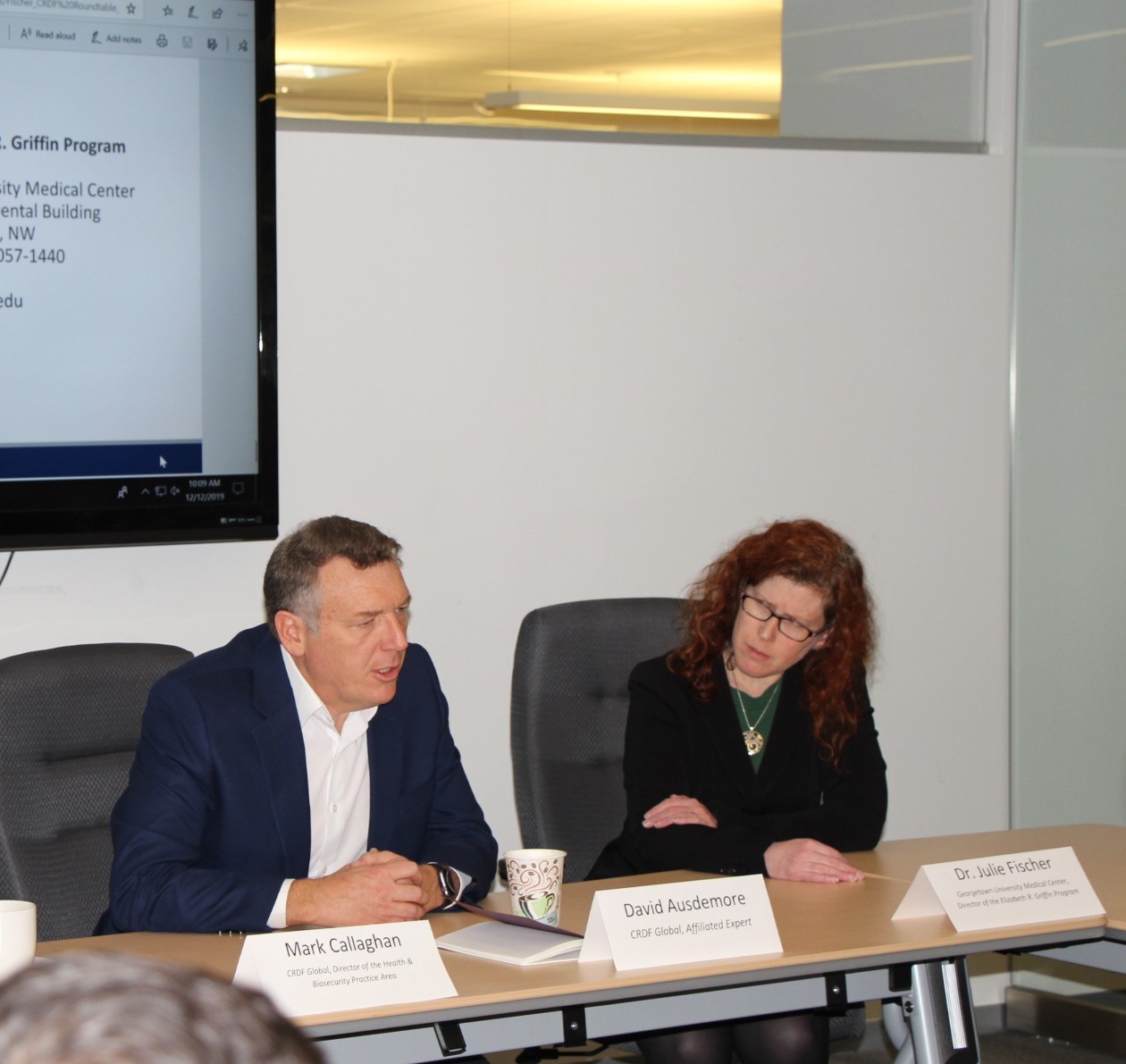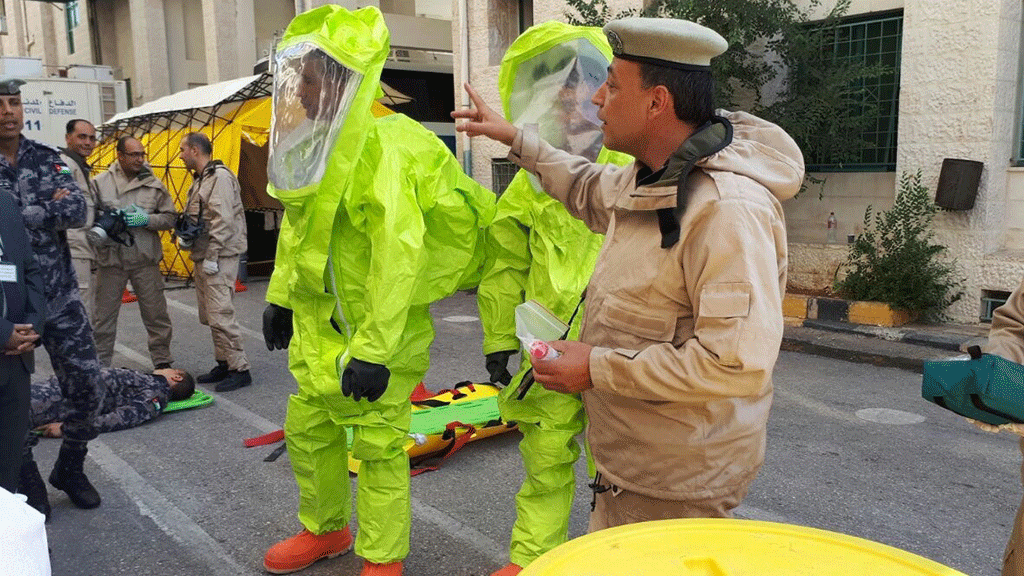Implementing Global Health Security Programs in Austere and High-Risk Regions

Today, a health threat anywhere is a health threat everywhere. Within 36 hours, a disease can spread from an austere rural village to any major city, regardless of the sophistication of its health system. The growing rate of international travel, trade and a rapidly expanding global population have inadvertently created new avenues for the spread of disease on a global scale. On Thursday December 12, 2019, CRDF Global hosted a roundtable discussion to explore just that. Industry leaders and professionals gathered to share their lessons learned and best practices to combat the universal challenges associated with improving health security in high-risk regions.
David Ausdemore, founder of Health Systems Sciences, LLC and affiliated expert with CRDF Global, has more than 25 years of experience in health, safety, and environmental-related project implementation to support risk management and public health emergency responses. As a former technical advisor for the U.S. Centers for Disease Control and Prevention (CDC), Mr. Ausdemore implemented programs focused on strengthening international health systems, policy measures and biosafety procedures related to the spread of infection – both at CDC headquarters and on site in over a dozen countries.
Mr. Ausdemore quickly discovered during his time at CDC that the get in, get out mindset he had acquired while in the military would not yield effective results when working in transboundary outbreak scenarios to improve global health systems. In order to really make a difference, there had to be that genuine level of trust between the civilians and the responders.
During the roundtable, he told the story of a colleague of his who, while working to contain the Ebola virus disease (EVD) outbreak in east Africa, spent time getting to know the civilians of the afflicted town before being trusted enough to lend support. “It took two weeks of building those relationships before they finally had the trust that their loved ones would not be taken away from them and never heard from again,” he said.
Dr. Julie Fischer of the Georgetown University Medical Center backed this statement, referencing her own experiences working in Libya, Tanzania and Thailand. “What we have found works best is trust. It requires sustained conversation and taking the time to learn enough about the system in which you are working to ask more questions,” she said.
As co-director of the Elizabeth R. Griffin Program for the Center for Global Health Science and Security at Georgetown University, Dr. Fischer works to strengthen leadership in collaborative research and education related to global health security best practices. Prior to her time at Georgetown University, she led several projects to support government and international agencies in their ability to detect, assess, report and manage emerging public health events. She also directed the Global Health Security Program at the Stimson Center and worked to strengthen global capacity for disease detection and response.
Dr. Fischer recalled that the objective of her team, including CRDF Global, in North Africa was to establish long-term partnerships with multiple institutions, including the Libyan National Committee for Biosafety and Bioethics (LNCBB), and continue working with them in the future. The goal was never to set up a “one and done” initiative, but rather to create an ongoing partnership that provided long-term mentoring and shared use of tools and training materials. Dr. Fischer emphasized the importance of working with government organizations in these high-risk areas to help them build – not sustainable practices, as that would imply the structures would remain unchanged – but durable practices.
“A lot of what we do when we are ‘capacity building’ is similar to what construction companies do when they are foundation building…different settings require different kinds of foundation. No one wants to hear that a process is going to take months to years, but the reality is, you don’t build capacities – in an area where people are struggling with external challenges – overnight. But if you keep insisting on getting it right, even if you can’t wrap it up quickly, you can build something that will last. We talk a lot about sustainability, but what we are really talking about is durability.”
She further explained that the focus of global health stakeholders should be in creating durable practices – because once the international agencies leave, the resulting tool or program belongs to the local community, and it is their’s to adapt and use as they see fit. The important thing is that they have the resources to use it.
Following the presentations from Mr. Ausdemore and Dr. Fischer, the organizers opened the floor for questions, allowing for a discussion surrounding best practices for implementing global health security. One recurring theme that came up was the importance of establishing an ongoing, meaningful dialogue between the implementers and the local stakeholders of the high-risk regions. Once established, the perceptions and beliefs of both sides can be understood, and the trust created from this mutual understanding will facilitate the search for joint solutions in reducing the spread of disease.
Dr. Fischer recounted that the incorporation of realistic exercises and simulations to engage individuals in training programs had been a successful method for her in the past. She found that such exercises were useful as they placed the community members in hypothetical situations where they could devise a plan of action based on the tools and personnel available to them. Once the simulation was complete, the local stakeholders would discuss what was done well and what could be improved upon, thus creating the opportunity for the community to establish realistic and durable practices that could be carried out long after the end of the simulation periods.
When actively engaged, local stakeholders are the main actors in preventing, identifying, responding and recovering from the physical, psychological, social and economic impacts of outbreaks. They are the most affected by pandemic threats, and they have the greatest influence in anticipation and preparedness as new diseases emerge or old ones re-emerge. Therefore, in order to effectively prevent, detect and respond to emerging epidemics, global health stakeholders must work with communities at the local level to implement global health security best practices.



